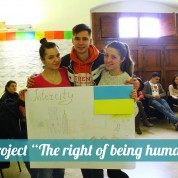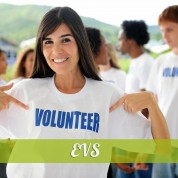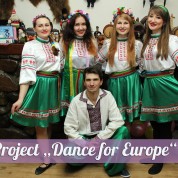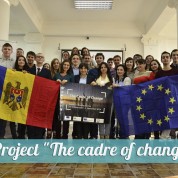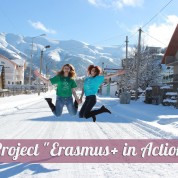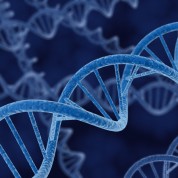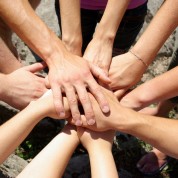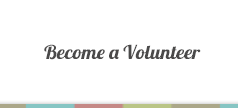Project “The right of being human”. Review
A project «The right of being human» was attended by youth workers from Portugal, Great Britain, Georgia, Armenia, Ukraine, Belarus, Austria, Italy, France and Moldova from 27 February to 8 March 2015 in the beautiful town of Nardo, Italy,
In the theoretical part of the project we reviewed and discussed all the categories of human rights, the real situation of human rights in each of the participating countries. The emphasis was placed on the rights that people neglected and which really honored. We also visited the public organization «Rinascita», which was the organizer of the project, met with three interesting people, refugees from Palestine, Iraq, Sinegal. They were talking about the hard life in their country, why did they leave it and started a new life in Copertino, Italy. Their stories absolutely amazed all of the participants; extremely difficult to understand all the pain of these people.
In the practical part of the training, we had an excellent opportunity to get acquainted with the basics of photo and video art. For many of us this process proved to be quite complex and required more dedication, we had to work late into the night to create a video . On the last day, the participants organized a flash mob in the main square of Lecce, the idea was to draw public attention to human rights, to comply with them and struggle.
Great news!
NGO “Rodyna” have passed the accreditation process for the program EVS. And now we have an opportunity to send and receive volunteers from Europe. We will receive offerings of longer duration of the projects soon!
Accreditation of Youth Volunteering Organisations (ERAPLUS-EVS-CHARTER) – 2014-1-PL01-KA110-003719
Project “Dance for Europe”. Review
Youth Exchange “Dance for Europe” was one of the most interesting and at the same time the most intensive projects I have ever participated in, because our main objective was to create a friendly team and intercultural dialogue due to my favorite activity and hobby – dancing. After seven days living together, sharing experiences, cultural features, original ideas, and colorful folk dances 40 extremely different people have become a big family. It took a week on the project for serious Germans to get closer to inflammatory Georgians, “hot” Spaniard to sensible Estonians, good-natured Czechs to enchanting Ukrainians, and even warring Azerbaijanis and Armenians became best friends. The project has become a little life, every day we had an opportunity to visit two countries at once. During intercultural evenings each country was representing a unique colouring, charming folk rhythms, dances and tasty traditional dishes and drinks. This project gave me an unforgettable experience as a choreographer, because our team conducted a workshop with Rock and Roll and Hip hop, then we embodied this choreography in Georgian school. Volunteering at school – is another key aspect of the project, because we were able to share everything that we have learned to bring joy to gloomy walls of poor rural schools. You can`t explain you how much positive emotions we received from young dancers who presented Georgian folk dance as an appreciation! There were a lot of emotions raged during skiing, as youth exchange took place in Georgia Bakuriani which is ski resort. This youth exchange gave me a lot of positive, memorable experience and faithful friends, thank you “Rodyna” for this great opportunity to introduce Ukraine at this wonderful project!
Project “The cadre of change”. Review
“For all the participants youth training «The cadre of change» was the first training session. Erasmus + is a program that is funded by the European Commission. Its main aim is to strengthen the cooperation between youth organizations and young people from European countries .Ukraine was represented by three members – Alex from Zaporozhye (student programmer), Varbara from Odessa (student-ecologist), Vlad (teacher, historian).
The main objective of the training, which we have visited, was to learn how to create photo and video about the problems that are important to young people. Therefore, the program was very intense. But this training does not seem to be the same as it is in schools and universities … In non-formal education there are no marks, no one should you, the main thing – it is your interest and purpose. And though our training was complete, but at the same time, incredibly interesting: we had games and exercises for team work, quests, many practical tasks.
On the last day of the training we organized a flash mob in the center of Chisinau (in front of the Government House :). After it we presented our video library. So our project ended with traditional Moldovan dinner and tour.” Vladislav Ivchenko
Project “Erasmus+ in Action”. Review
“Let me start my review with basic objectives of the project which were fully implemented. Such questions as youth cooperation, acquiring knowledge out of official university education, an opportunity to share experience and knowledge with other countries are extremely relevant to today’s youth from my point of view. The participants from Germany, Estonia, Spain, Czech Republic, Armenia, Azerbaijan, Georgia and Ukraine not only mastered their skills to create their own projects for youth exchanges, but got a real opportunity to cooperate in the nearest future, find out about NGOs in other countries and determine the characteristics of the formal and non-formal education in each country as well. The result of only one day was that all the guys were inspired by the idea to create their own projects and even outlined specific ways to implement and presented model of the future project. Very valuable for all of us was the process of sharing experience on the various spheres of life, which lasted almost 24 hours a day. And of course, a variety of training sessions allowed us to obtain the most from each coach and an active member of the team. It is impossible not to mention the hospitality of the Georgian organizers and lots of interesting excursions.” Nina (Zaporozhye)
Types of disability
You can find out the following disabilities and chronic illnesses:
- Spinal injuries
- Down syndrome
- Cerebral palsy
- Asperger’s syndrome
Spinal cord injury is permanent, but it doesn’t stop people from leading full and enjoyable lives. You can find out about:
What is a spinal cord injury?
Spinal cord injury occurs if pressure is applied to the spinal cord, and/or if blood and oxygen supply is cut off to the spinal cord. Spinal cord injuries can be caused by disorders and by trauma, such as damage resulting from road accidents, water and sports accidents, and falls. Spinal cord injury is permanent. In addition to causing the loss of the ability to walk, it affects many areas of a person’s body—such as the cardiovascular and respiratory systems, bladder and bowel function, temperature and sensory abilities. Young people are more likely to experience a spinal cord injury, with 42% of people who sustain an injury being between 15 and 30.
Down syndrome Around the world, up to 7 million people are estimated to be living with Down syndrome.
1 in 700 babies is born with Down syndrome, and children, young people and adults with Down syndrome vary in their interests, abilities, personalities and appearance.
Every person that has Down syndrome has a full or partial extra copy of a chromosome—chromosome 21—and they can share other similarities.
Over 100 features have been described in Down syndrome, but generally people with the syndrome have far fewer (often less than 10) of these features.
People with Down syndrome have a higher incidence of respiratory and heart conditions, and may also have intellectual disability to varying degrees. They:
- can have a wide range of skills and interests—and keep learning throughout their lives
- may live independently, or with limited support, as adults.
Most people with Down syndrome are able to read and write.
A person with Down syndrome may experience difficulties with their speaking, but they generally understand more than their speech indicates, and—just like everyone else—value being listened to and appreciated for who they are as a person.
Cerebral palsy
Cerebral palsy is one of the most common congenital (existing before birth or at birth) disorders of childhood. About 500,000 children and adults of all ages in the United States have the condition.
The three types of CP are:
- spastic cerebral palsy — causes stiffness and movement difficulties
- athetoid cerebral palsy — leads to involuntary and uncontrolled movements
- ataxic cerebral palsy — causes a disturbed sense of balance and depth perception
Cerebral palsy affects muscle control and coordination, so even simple movements — like standing still — are difficult. Other vital functions that also involve motor skills and muscles — such as breathing, bladder and bowel control, eating, and learning — may also be affected when a child has CP. Cerebral palsy does not get worse over time.
Asperger’s syndrome
Aspergers is a neuro-developmental disorder that is classified as an autistic spectrum disorder (ASD). Research undertaken by the Australian Advisory Board on Autism Spectrum Disorders shows that there is on average 1 child with an autism spectrum disorder in every 160 children aged 6 to 12 years old.
Not all people that display genius have Aspergers; nor do all people that are diagnosed with Aspergers become recognised as a genius. However, there does seem to be an element of brilliance and creativity in the realm of Aspergers.
As children, people with Aspergers can be considered a ‘walking encyclopedia’ or ‘little professor’ as they are incredibly knowledgeable about a topic that captures their interest. It is this unique ability to delve deeply into a particular area of interest that has been credited with playing a crucial role in bringing about innovation and creativity-often in maths and science, but in many other fields as well.
With ASDs, three main areas of development are affected.
Social interaction:
- don’t develop friendships appropriate to developmental level
- non-verbal behaviour is impaired; e.g. limited eye contact and facial expressions
- ability to identify social cues and conventions is impaired
- don’t spontaneously seek to share enjoyment, interest or achievements with others.
Behaviour:
- develop special interests that are unusual in their intensity and focus
- prefer routine and consistency.
Communication:
- fluent speech although have difficulty with conversation
- misinterpret language; e.g. may take things literally.
Become a volunteer
We know that offer active and able to strongly change the world and ourselves better. We need your talents and capabilities. Let’s create together a team of people ready to help those in need. You need our “family”! If you possess free time, useful links, seeks to specific actions, and want to do something for us, become our volunteer. Your help is very important for us and we need it in the daily work of the organization. Please write about you motivation desire to volunteer by filling aplication form.

